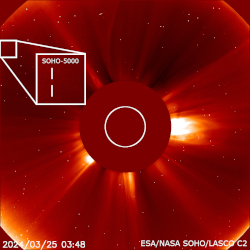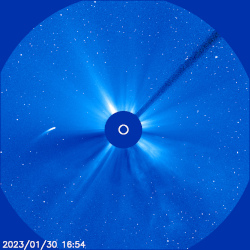SOHO Discovers 5,000th Comet (March 27, 2024)
SOHO has discovered its 5,000th comet! A citizen scientist in the Czech Republic spotted a comet in a SOHO image, which has now been confirmed to be the 5,000th comet discovered using SOHO data.
SOHO-5000 (left image) is a small comet belonging to the so-called "Marsden group." They are thought to be related to a larger comet that SOHO has seen before, 96P/Machholz (right image).
|
|
|
The comet was spotted on March 25, 2024, by a citizen scientist and longtime participant in @DoNASAScience's Sungrazer Project, Hanjie Tan, who made his first comet discovery at age 13. Today he is pursuing his PhD in astronomy in the the Czech Republic.
Sungrazer Project lead Karl Battams (NRL), had this to say: "Sungrazer has been with me my entire career, so to see it get SOHO to this milestone is beyond thrilling. I'm delighted for all the project volunteers who, over the past 20+ years, have made Sungrazer so engaging, inspiring, and rich with science."
SOHO has achieved this milestone over 28 years in space, even though it was never designed to be a comet hunter. Thanks to the hard work of Sungrazer Project comet hunters around the world, SOHO is already the most prolific comet-hunting spacecraft in history, and it is not slowing down!
Congratulations to SOHO and to the The Sungrazer Project participants!
Links (more images, videos and full story):
- SOHO reaches 5000 comets from ESA
- ESA, NASA Solar Observatory Discovers Its 5,000th Comet from NASA
- The Sungrazer Project and a YouTube video describing how volunteers help ESA and NASA discover comets
SOHO began its Weekly Pick several years ago after sending a weekly image or video clip to the American Museum of Natural History (Rose Center) in New York City. There, the SOHO Weekly Pick is displayed with some annotations on a large plasma display. Today, we use this area as 'Solar Picks' to highlight stories, events or activities but not as often as every week.




